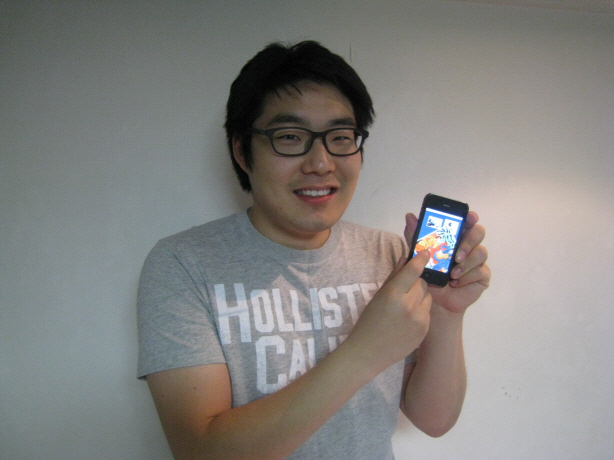people
A student’s small idea was transformed into a viable technology, yielding 500 million won through the technology transfer.
In a mobile environment, it is difficult to hold the device and use its multi touch function, at the same time. A doctorate candidate of the KAIST Cultural Technology Graduate School, Hwang Sung Jae (28 years old), identified the inconvenience that it is hard to see the full screen of a mobile phone while manipulating it, and he invented a helper called “Virtual Thumb.”
The thumb allows a user to use only one finger to perform tasks that require the movements of several fingers like punching, zooming in/out and rotating the screen. When the user touches a screen, a virtual finger is created on the other side of the screen and mimics the motion of the user’s touching.
The ‘virtual Finger’ technology is based on the idea that came in second in the 2009 Korea Invention Patent Competition hosted by the Korea Intellectual Property Office and can be applied to any device that has a touch-based system which spans from a TV remote controller to a Tablet PC’s.
The Office of University and Industry Cooperation, KAIST, facilitated to turn Hwang’s idea into commercialization, and on October 18, Victronix, a Korean mobile phone manufacturer, bought a patent right for the technology at 500 million won.

-
research KAIST Develops AI That Automatically Designs Optimal Drug Candidates for Cancer-Targeting Mutations
< (From left) Ph.D candidate Wonho Zhung, Ph.D cadidate Joongwon Lee , Prof. Woo Young Kim , Ph.D candidate Jisu Seo > Traditional drug development methods involve identifying a target protin (e.g., a cancer cell receptor) that causes disease, and then searching through countless molecular candidates (potential drugs) that could bind to that protein and block its function. This process is costly, time-consuming, and has a low success rate. KAIST researchers have developed an AI model th
2025-08-12 -
research “One Experiment Is All It Takes”: KAIST Team Revolutionizes Drug Interaction Testing, Replacing 60,000 Studies
A groundbreaking new method developed by researchers at KAIST and Chungnam National University could drastically streamline drug interaction testing — replacing dozens of traditional experiments with just one. The research, led by Professor Jae Kyoung Kim of KAIST Department of Mathematical Sciences & IBS Biomedical Mathematics Group and Professor Sang Kyum Kim of Chungnam National University's College of Pharmacy, introduces a novel analysis technique called 50-BOA, published in Natu
2025-06-16 -
research “For the First Time, We Shared a Meaningful Exchange”: KAIST Develops an AI App for Parents and Minimally Verbal Autistic Children Connect
• KAIST team up with NAVER AI Lab and Dodakim Child Development Center Develop ‘AAcessTalk’, an AI-driven Communication Tool bridging the gap Between Children with Autism and their Parents • The project earned the prestigious Best Paper Award at the ACM CHI 2025, the Premier International Conference in Human-Computer Interaction • Families share heartwarming stories of breakthrough communication and newfound understanding. < Photo 1. (From left) Professor Hw
2025-05-19 -
event Dongwon Group Honorary Chairman Kim Jae-chul Donates a Total of 54.4 Billion Won to KAIST
- Dongwon Group Honorary Chairman Kim Jae-chul, following his 2020 donation of 50 billion won, donates an additional 4.4 billion won to strengthen the AI education and research infrastructure - The additional donation of 4.4 billion won will be used to build a new AI education and research building - “In the AI era, there will be a new future in the sea of data. Please become the world’s No. 1 research group.” - Honorary Chairman Kim Jae-chul < Photo 1. Kim Ja
2025-01-06 -
event KAIST to begin Joint Research to Develop Next-Generation LiDAR System with Hyundai Motor Group
< (From left) Jong-Soo Lee, Executive Vice President at Hyundai Motor, Sang-Yup Lee, Senior Vice President for Research at KAIST > The ‘Hyundai Motor Group-KAIST On-Chip LiDAR Joint Research Lab’ was opened at KAIST’s main campus in Daejeon to develop LiDAR sensors for advanced autonomous vehicles. The joint research lab aims to develop high-performance and compact on-chip sensors and new signal detection technology, which are essential in the increasingly compe
2024-02-27